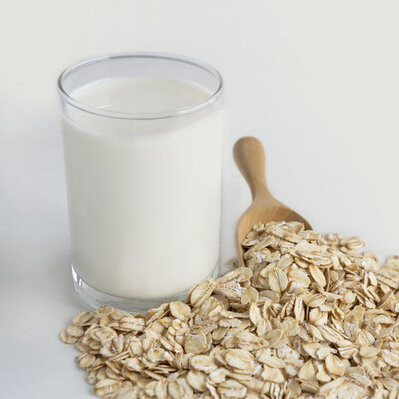
Oat Milk
Also known as oat drink or baristas mix
What is Oat Milk?
Oat milk is a plant-based fluid commonly used to substitute animal-based milk. It is made from dehulled oat kernels through an enzymatic process. Oat milk is gluten-free, has a mild natural sweet flavor and excellent functionality, thus making it an ideal cow’s milk substitute.1
- Consumption of oat milk and other plant-based drinks is driven by today’s consumer interest in healthy, ethical and sustainable diets. 1
- In baking, oat milk is used as a milk substitute in various products.
Origin of oat milk
This milk was first developed in the early 1990s by the Swedish scientist Rickard Oste while searching for a plant-based substitute of cow’s milk.2
Today, it is one of the most commonly used plant-based milk substitutes and is used in a wide variety of products like yogurts, ice cream, spreads and smoothies.1,2
Function
Similar to cow’s milk, this plant-based milk provides several benefits to bakery systems:
- Moisture: for dissolution of salt and sugars, and aids in gluten development.
- Color: provides sugar and proteins for Maillard browning reaction.
- Flavor: provides a milk oaty flavor.
- Foaming: creates a stable foam, similar to cow’s milk.
- Nutritional value: provides fiber, mainly beta-glucan.
Nutrition
Typical nutritional value of a commercial oat milk per 240 mL:3
| Component | Grams |
|---|---|
| Carbohydrate | 19-29 |
| Fat | 4.5-5 |
| Protein | 2.5-5 |
Oat milk provides 140 -170 kcal per cup (240 mL). It is naturally gluten-free. However, care should be taken when it is produced in facilities that handle other cereals containing food allergens.
This milk is usually recommended for people with irritable bowel syndrome (IBS) as part of an anti-inflammatory diet.
Commercial production
Oat milk or oat drink is industrially manufactured through the following process:1
- Grinding: dehulled oat kernels are ground into a fine flour.
- Mixing: the flour is mixed with hot water at 60 – 90 oC (140 – 194 oF) in a high shear mixer tank to gelatinize starch.
- Enzyme treatment: alpha-amylase is added to the mixing tank to hydrolyze starch and increase viscosity. Subsequently, a second enzyme (glucosidase or beta-amylase) is introduced to break down glucose/maltose units.
- Enzyme inactivation: enzyme activity is stopped by heating up to 95 – 100 oC (203 – 212 oF) for 80 s.
- Fiber separation: insoluble fiber is separated from the oat drink in a centrifugal decanter to improve appearance and adjust viscosity of the product.
- Blending: oil, calcium salts or stabilizers depending on the formulation are added to the oat drink in a high shear mixer.
- Homogenization: this step breaks down fat globules into smaller ones to delay creaming and improve the product shelf-life.
- Packaging
Application
Several types of baked goods such as cookies, muffins, cakes and cupcakes can be made with this milk. Custards, however, are not good candidates for milk replacement by oat milk due to the absence of milk proteins that aid in egg coagulation .1,2
Typically, cow milk can be substituted 1:1 with oat milk, producing similar results in common baked products.1
Regulations
Oat milk is considered safe by the FDA. Currently, there is a debate around whether plant-based alternatives to dairy products should use terms such as: milk, cheese or yogurt due to the difference in nutritional value between plant-based and animal-based products.
In the EU, oat milk is considered safe. However, a similar debate exists around the use of dairy terms for plant-based products. The terms milk, butter, yogurt, cream and buttermilk are reserved for animal derived products according to the EU Commission No 1308/2013.5
References
- Tetra Pak International. White Paper: Oat-based beverages. Processing Challenges & Techniques. GB: Tetra Pak International S.A, 2020.
- Galanakis, Charis M., ed. Trends in non-alcoholic beverages. Academic Press, 2019.
- Gutiérrez, Tomy J., ed. Food Science, Technology and Nutrition for Babies and Children. Springer Nature, 2020.
- Goldman, Eric. “Use of the Names of Dairy Foods in the Labeling of Plant-Based Products.” 2018.
- European Commission (Ec). Commission Regulation (Eu) No 1308/2013 Of The European Parliament And Of The Council Of 17 December 2013 Establishing A Common Organisation Of The Markets In Agricultural Products And Repealing Council Regulations (Eec) No 922/72, (Eec) No 234/79, (Ec) No 1037/2001 And (Ec) No 1234/2007 . Official Journal Of European Communities, 12 December 2013.

